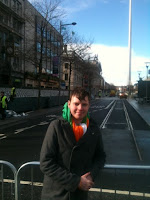Overall, I have not gone overboard in my celebration of the 1916 Easter Rising. Certainly, I could have gone to a lot of public events and attended many talks and lectures connected to the rebellion. Living in a nationalist town like Newry the opportunity has presented itself constantly. However, I felt that this would have been overkill and unnecessary. Firstly, I do not have the time to devote myself to such a commitment and secondly, I have a significant knowledge of the 1916 Easter Rising already thanks to both my A-level and university studies at the Abbey CBS and Queen's University Belfast, respectively. I have a strong grounding in the causes and consequences of the rising as well as its significance in the World War I context. I have read a variety of academic perspectives and I am satisfied that I have a solid appreciation of the event's importance in Irish history.
It was due to these reasons that I decided that the most fulfilling way to celebrate this momentous event would be in Dublin at the state's official commemoration ceremony and parade outside the General Post Office, the headquarters of the 1916 revolutionaries - not by participating in the Newry Easter parade and commemoration ceremony at the Republican plot in St Mary's graveyard like most other years. That would not be enough in 2016.

I attended the state ceremony with my brother who was just as determined as myself to witness the event. Even the bitter wind blowing off the Liffey did not dim our spirits as we waited for the ceremony to start. We ended up spending the entire commemoration's duration on the Bachelors Walk boardwalk just off O'Connell Bridge and were able to view the crowds assembled along there as well as the large TV screen erected on D'Olier Street.
Although the time spent waiting on the Irish Army's individual salutes to the Defence Minister, acting Taoiseach and the President seemed to drag on the rest zoomed by in comparison. The four children (each representing their native province) presenting a bouquet of daffodils each at the foot of the GPO was a nice touch as were the songs played by the army piper. For me, however, the key moments were the reading aloud of the proclamation, the lowering of the national flag to half mast for the one minute's silence as well as its re-hoisting to full mast and the rendition of Amhrán na bhFiann.
Indeed, it was while singing the national anthem and surveying the crowds on O'Connell Bridge that the thought occurred to me about measuring the success of the 1916 rebels.
Sure, the rising was a military failure although there is much academic debate about whether there was any intention for it to be a military success at all. It was, however, a symbolic victory in that it represented a starting point for the independence struggle. Undoubtedly the revolutionaries were also aided and abetted by the British government-ordered executions which acted as a great propaganda coup for the republican movement once the public mood turned against the government's draconian response.
Finally, in contrast to past attempted insurrections (like 1798 and 1848), the 1916 rebellion pulled on the nation's heartstrings. It left an indelible mark on the Irish mindset which was evidenced during the fiftieth anniversary and is apparent now during the centenary year. For me, the rising's success was measurable on Easter Sunday in the hearts and minds of the people, Gael and Gall, who lined O'Connell Street despite the bitter wind, listened intently to the words of the hundred year-old proclamation and belted out Amhrán na bhFiann passionately. Indeed, I am convinced that the descendants of those people will again assemble across O'Connell Street listening with the same intent and singing with identical passion and pride during the 150th and 200th commemorations in 2066 and 2116, respectively, just as their fore-bearers did in 1966 and 2016. That is the real success of the 1916 rebels.
No comments:
Post a Comment